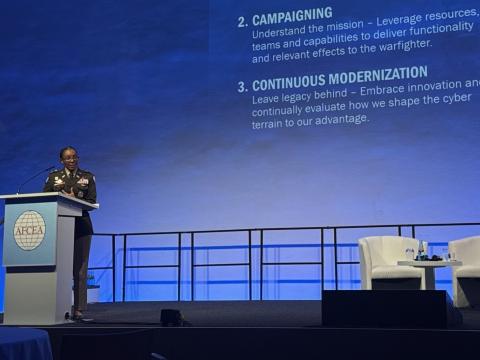Pentagon Eyes Stronger Cyber Command Recruiting
The U.S. Cyber Command (CYBERCOM), the military’s combatant command that conducts defensive and offensive cyber operations for the nation and with allies, will be “integrating” with the other military departments to “recruit, assess, select, train and retain” the department’s cyber forces, the Pentagon said in a November 6 press release.
“The Department of War is establishing a revised cyber force generation model, aimed at increasing the lethality of the department’s cyber forces and providing greater operational outcomes for the joint force,” the statement said. “The revised model, based on core attributes and key organizations, enables the department to build mastery, specialization and agility in the cyber forces assigned to the United States Cyber Command.”
The Pentagon sees the revised policy as a better approach to meet the specific requirements of CYBERCOM’s force and recruitment—especially in the face of continued adversarial cyber actions from China.
“Since its inception over a decade ago, CYBERCOM has relied on traditional military services’ man, train and equip models to source its cyber forces,” the policy indicated. “While appropriate for other warfighting domains, these traditional models have not met the unique requirements necessary to fight and win in the cyber domain.”
The command lacks a confirmed commander, with Lt. Gen. William Hartman serving as acting commander after the abrupt departure of Gen. Timothy Haugh, USAF, in April only a little more than a year after taking command as the fourth leader of CYBERCOM.
The policy identified seven “core attributes” to improve recruitment and retention of the cyber force.
- Targeted recruiting and assessments: recruit for assignment to CYBERCOM and assess for cyber work role fit.
- Incentives to recruit and retain top cyber talent: incentivize cyber domain mastery and retain talent within the Cyber Mission Force.
- Tailored and agile advanced training: provide specialized, mission-specific training to meet operational requirements.
- Tailored assignment management: adopt career paths that enable the development and retention of cyber domain mastery within the Cyber Mission Force.
- Specialized mission sets: shape unit specialization and collective training based on tailored mission requirements.
- Presented with headquarters and combat support: present fully functional tactical headquarters that drive operational outcomes.
- Optimized unit phasing: implement unit phasing to support a sustainable operational tempo.
The policy also named three CYBERCOM organizations involved in the efforts: the Cyber Talent Management Organization, the Advanced Cyber Training and Education Center, and the Cyber Innovation Warfare Center.
The talent management office will be the organization to identify, attract, recruit and retain the cyber force. The training and education center will develop and implement “mission-specific” training, while the innovation center will “accelerate the rapid development and delivery of operational cyber capabilities,” according to the statement.
“This model will accelerate our efforts to build the leading cyber capabilities required to address acute and emerging cyber threats, and to deter escalating aggression in the cyber domain,” said Under Secretary for Personnel and Readiness Anthony J. Tata.
Tata said Secretary of Defense Pete Hegseth was “acting swiftly to establish policy, implement programs and execute a new approach to recruiting, developing and retaining cyber talent, ensuring that we remain ready to achieve peace through strength.”






Comments